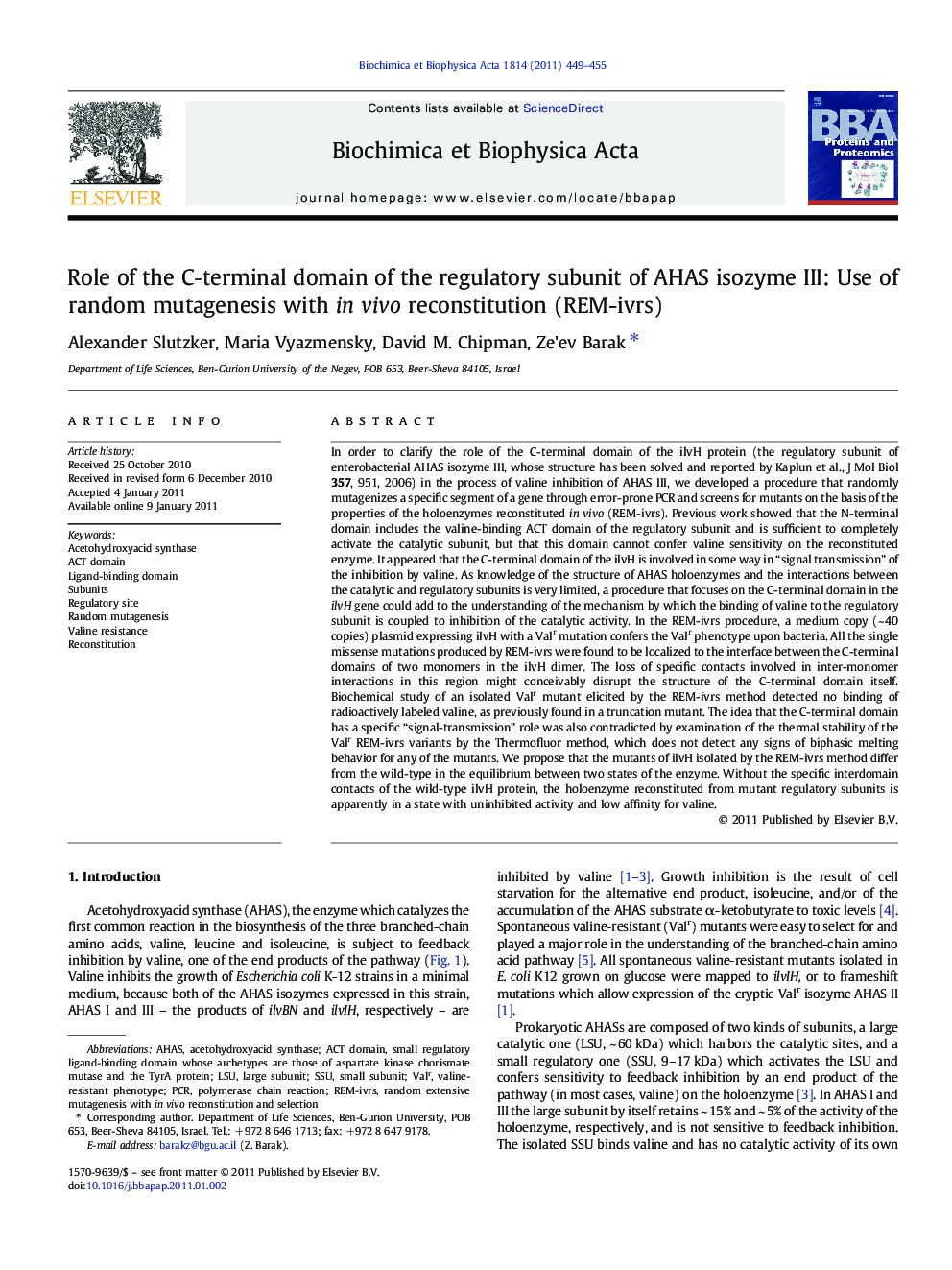| کد مقاله | کد نشریه | سال انتشار | مقاله انگلیسی | نسخه تمام متن |
|---|---|---|---|---|
| 1178814 | 962729 | 2011 | 7 صفحه PDF | دانلود رایگان |

In order to clarify the role of the C-terminal domain of the ilvH protein (the regulatory subunit of enterobacterial AHAS isozyme III, whose structure has been solved and reported by Kaplun et al., J Mol Biol 357, 951, 2006) in the process of valine inhibition of AHAS III, we developed a procedure that randomly mutagenizes a specific segment of a gene through error-prone PCR and screens for mutants on the basis of the properties of the holoenzymes reconstituted in vivo (REM-ivrs). Previous work showed that the N-terminal domain includes the valine-binding ACT domain of the regulatory subunit and is sufficient to completely activate the catalytic subunit, but that this domain cannot confer valine sensitivity on the reconstituted enzyme. It appeared that the C-terminal domain of the ilvH is involved in some way in “signal transmission” of the inhibition by valine. As knowledge of the structure of AHAS holoenzymes and the interactions between the catalytic and regulatory subunits is very limited, a procedure that focuses on the C-terminal domain in the ilvH gene could add to the understanding of the mechanism by which the binding of valine to the regulatory subunit is coupled to inhibition of the catalytic activity. In the REM-ivrs procedure, a medium copy (~ 40 copies) plasmid expressing ilvH with a Valr mutation confers the Valr phenotype upon bacteria. All the single missense mutations produced by REM-ivrs were found to be localized to the interface between the C-terminal domains of two monomers in the ilvH dimer. The loss of specific contacts involved in inter-monomer interactions in this region might conceivably disrupt the structure of the C-terminal domain itself. Biochemical study of an isolated Valr mutant elicited by the REM-ivrs method detected no binding of radioactively labeled valine, as previously found in a truncation mutant. The idea that the C-terminal domain has a specific “signal-transmission” role was also contradicted by examination of the thermal stability of the Valr REM-ivrs variants by the Thermofluor method, which does not detect any signs of biphasic melting behavior for any of the mutants. We propose that the mutants of ilvH isolated by the REM-ivrs method differ from the wild-type in the equilibrium between two states of the enzyme. Without the specific interdomain contacts of the wild-type ilvH protein, the holoenzyme reconstituted from mutant regulatory subunits is apparently in a state with uninhibited activity and low affinity for valine.
Graphical AbstractFigure optionsDownload high-quality image (36 K)Download as PowerPoint slideResearch Highlights
► Small subunit ilvH of heterooligomeric AHAS III required for valine-inhibition.
► ilvH C-terminal domain required for valine-inhibition but valine site in ACT domain.
► C-terminal domain mutants isolated by induction in-vitro + recomb-selection in-vivo.
► Random mutants mapped to region of interdomain contacts in the known structure.
► ilvH C-terminal domains probably modulate equilibrium between states of ACT domains.
Journal: Biochimica et Biophysica Acta (BBA) - Proteins and Proteomics - Volume 1814, Issue 3, March 2011, Pages 449–455